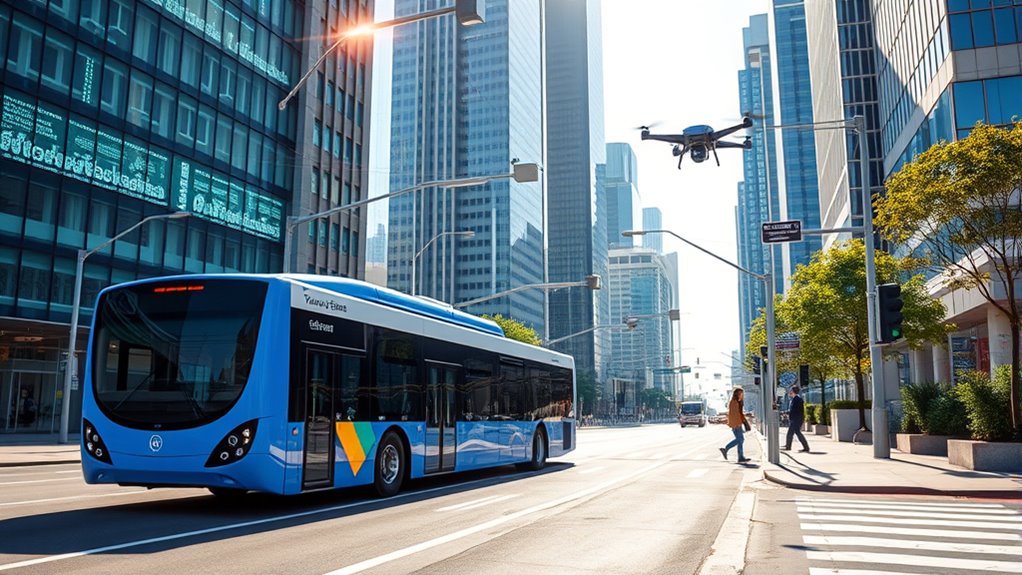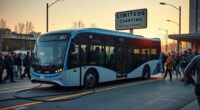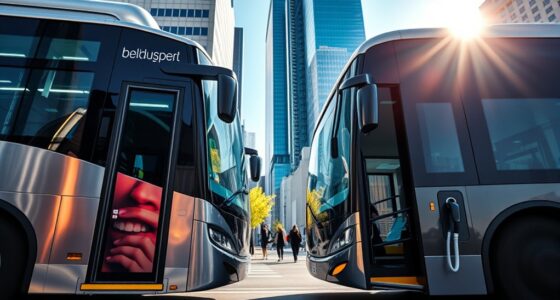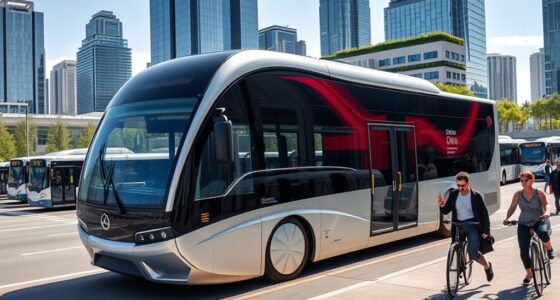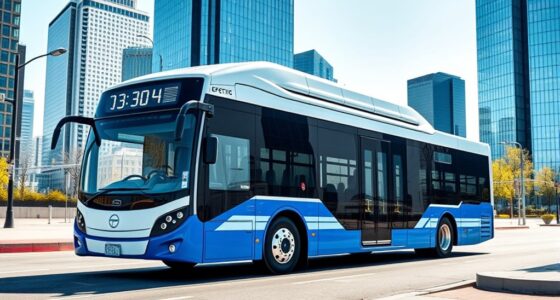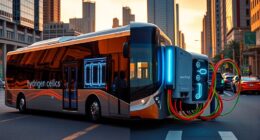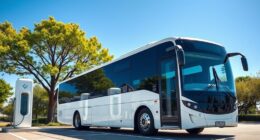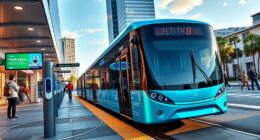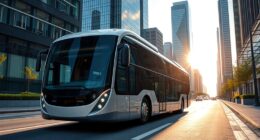Integrating electric buses with smart city infrastructure makes urban transportation more efficient, sustainable, and connected. You benefit from data analytics that optimize energy use, while smart charging systems connect seamlessly with city grids to reduce costs. Smart traffic signals and digital bus stops improve flow and passenger experience. These innovations support cleaner environments and better services, creating a smarter, greener city. To discover more about how this transformation happens, keep exploring these advancements and their seamless implementations.
Key Takeaways
- Electric buses utilize real-time data analytics for optimizing energy use and operational efficiency within smart city networks.
- Integration of renewable energy sources with smart charging systems ensures sustainable and efficient powering of electric buses.
- Smart infrastructure like sensor-equipped bus stops and synchronized traffic lights enhance safety and reduce delays for electric bus transit.
- Connectivity solutions enable seamless communication between buses, charging stations, and city grids for precise energy management.
- Digital information services improve passenger experience with real-time updates, safety features, and smart transit environment integration.
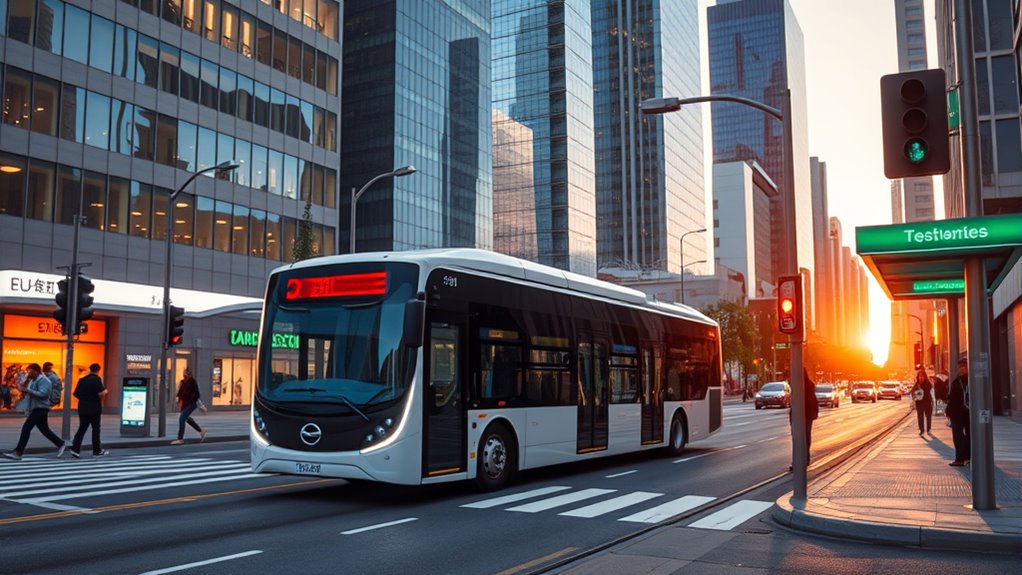
Smart city infrastructure is transforming urban transportation by integrating advanced technologies that make electric buses more efficient, sustainable, and passenger-friendly. As you navigate these modern systems, you’ll notice how data analytics play a crucial role in optimizing energy consumption and operational efficiency. City planners use sophisticated algorithms to analyze real-time data, helping electric buses consume less power while maintaining reliable schedules.
Smart charging systems, which connect seamlessly with city grids, ensure that buses recharge during off-peak hours, preventing strain on the electrical network. Vehicles communicate directly with charging stations, allowing for precise energy use and quick turnaround times. This connectivity not only streamlines operations but also reduces costs and environmental impact.
You’ll also see how electric buses leverage connectivity solutions to improve traffic flow. Smart traffic management systems coordinate traffic lights and bus routes, minimizing delays and idling times, which further conserves energy. These systems create a smoother transit experience, making your commute more predictable and less stressful.
Additionally, passenger experience benefits considerably from these technological integrations. Real-time information services keep you updated on schedules, delays, and routes, improving overall satisfaction. Enhanced smart bus stops and shelters are now equipped with digital displays and Wi-Fi, offering added convenience and safety during your wait.
Electric buses are increasingly powered by renewable energy sources such as solar and wind, making your transportation even greener. Cities are investing heavily in renewable energy infrastructure, which supplies clean power directly to bus charging stations. This integration reduces greenhouse gas emissions and supports the broader goal of sustainable urban living. Moreover, integrating renewable energy sources with transportation infrastructure helps reduce reliance on fossil fuels and promotes a cleaner environment.
Excess renewable energy can be stored for later use in buses or fed back into the grid, thanks to innovations like vehicle-to-grid (V2G) technology. This capability allows electric buses to act as mobile energy storage units, providing emergency power during outages or natural disasters, and helping stabilize the grid during peak demand.
Smart city infrastructure also adapts to support the unique needs of electric buses. Bus stops and shelters are now multifunctional, equipped with sensors, charging ports, and digital information displays. Smart traffic lights are synchronized with bus schedules, cutting down on unnecessary idling and improving overall traffic efficiency. Additionally, implementing energy management strategies ensures a more sustainable and cost-effective operation of the entire transportation network. Incorporating integrated systems can further enhance operational coordination and efficiency across urban transit networks.
Data-driven transit systems analyze usage patterns to optimize routes and schedules, ensuring you experience a more reliable service while cities reduce operational costs. These technological enhancements create safer, more convenient environments for passengers, with real-time updates and improved safety features.
Moreover, understanding the spiritual energy involved in human interactions and environmental harmony can inspire the development of more sustainable and mindful urban planning practices, fostering a deeper connection between technology and well-being.
While the future holds promising opportunities, challenges like high initial costs and scalability remain. Nevertheless, ongoing advancements in battery technology and integrated smart systems promise to make electric buses a cornerstone of sustainable urban mobility.
Your city’s commitment to developing smart infrastructure ensures that electric buses will continue to evolve, offering cleaner, more efficient, and passenger-centric transportation options for years to come.
Frequently Asked Questions
How Do Electric Buses Impact City Traffic Flow?
Electric buses improve city traffic flow by operating quietly and smoothly, which helps reduce congestion and allows for flexible routing near residential areas. Their efficiency in crowded spaces and potential for autonomous driving further optimize traffic movement.
Plus, with proper charging infrastructure, they can run longer routes without delays. These factors work together to make urban traffic more fluid, less noisy, and environmentally friendly, enhancing overall city mobility and quality of life.
What Are the Maintenance Challenges for Integrated Electric Bus Systems?
You face maintenance challenges like managing battery resilience, which varies with weather and usage, and scheduling timely upkeep.
Charging infrastructure costs and availability can cause delays, affecting service reliability.
You also need to monitor systems in real-time to detect issues early, ensuring peak performance.
Additionally, training staff and maintaining local technical support are essential, especially as component durability and system upgrades play a critical role in keeping electric buses operational and efficient.
How Do Smart Grids Support Electric Bus Charging Needs?
Smart grids support your electric bus charging needs by enabling real-time communication between chargers, utilities, and buses. They adjust charging based on grid capacity, prevent overloads through load balancing, and reduce costs with optimized energy use.
You benefit from automated demand response during peak hours, ensuring reliable charging without stressing the grid. Plus, they integrate renewable energy sources, making your fleet’s charging more sustainable and future-proof.
What Cybersecurity Measures Protect Smart City and Bus Data?
Cybersecurity creates a vital shield around your smart city and bus data. You should implement multi-layered measures like firewalls, intrusion detection, and encryption to block breaches.
Regular updates and rigorous monitoring help detect vulnerabilities early.
Applying access controls and adopting a Zero Trust approach guarantees only authorized users access sensitive information.
These proactive practices protect public trust, preserve privacy, and promote a safe, secure, and smart city environment.
How Are Passenger Privacy Concerns Addressed With Smart Bus Tech?
You’re concerned about passenger privacy with smart bus tech, and there are clear measures to address this. You’ll find that data collection is transparent, with clear policies and opt-in options so you control what’s shared.
Your data is anonymized and encrypted, and third-party sharing is restricted. You can review, delete, or update your information through secure portals, ensuring your privacy is protected while enjoying smart transit services.
Conclusion
By seamlessly integrating electric buses into smart city infrastructure, you pave the way for a more sustainable and vibrant future. This gentle shift not only honors our environment but also nurtures the well-being of your community. Embracing this change allows you to foster a cleaner, brighter city where progress and nature coexist harmoniously. Together, you can create a legacy of innovation and care, softly guiding your city toward a more hopeful and resilient tomorrow.
